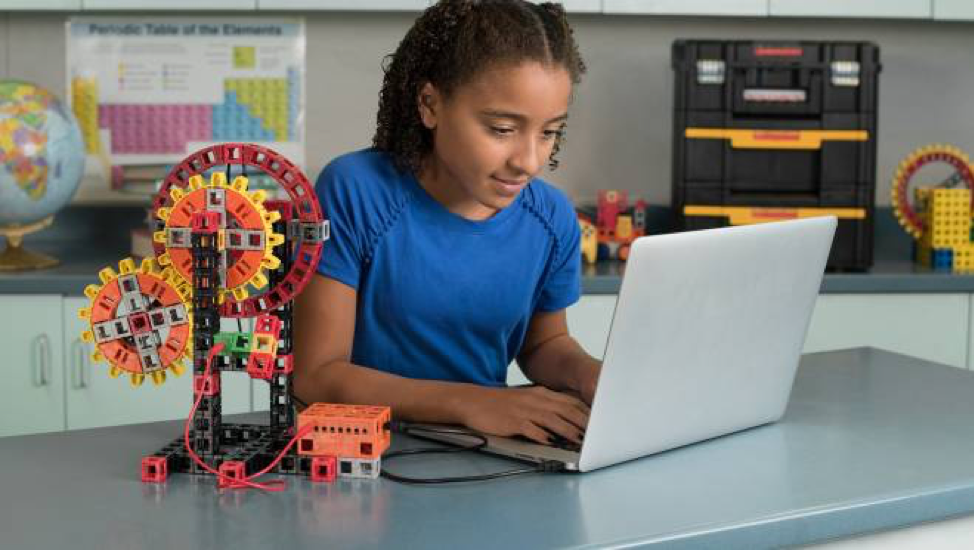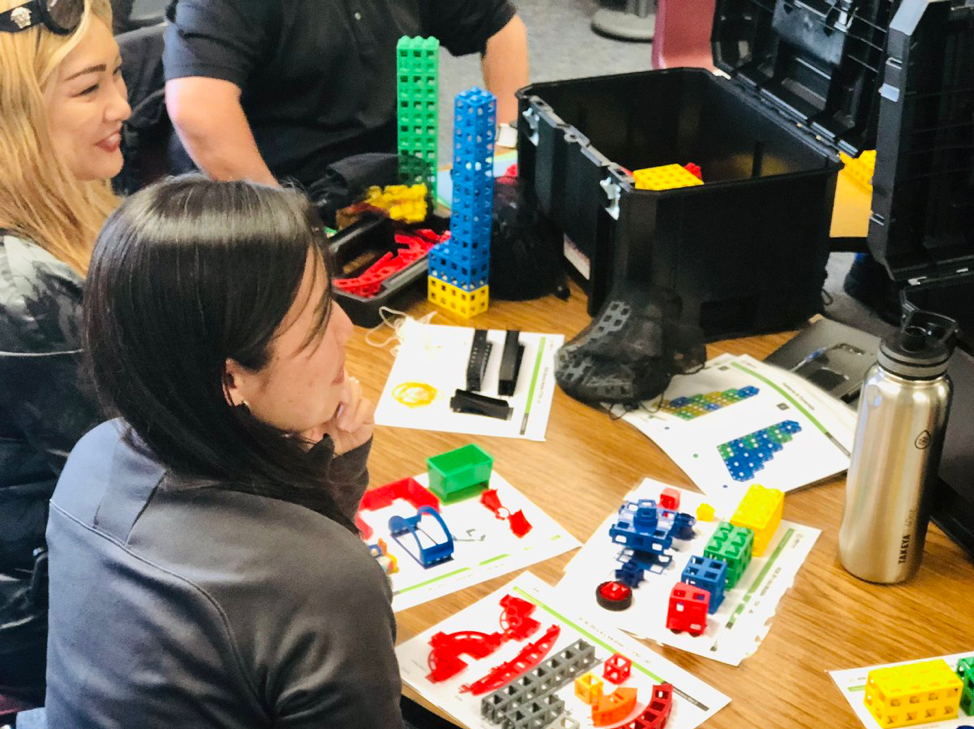| Kid Spark helps students to design creative engineering solutions to real-world problems while experimenting with simple machines. 1. The Kid Spark blocks can be combined to demonstrate mechanical principles. |
Educators looking for a new approach to teaching engineering principles in the classroom face a difficult decision between different types of learning tools. Common recyclable materials are easy to source, but it’s often difficult for them to demonstrate mathematical relationships between simple machines when none of the parts match precisely. On the other hand, precision engineered kits are often too specific to be used to demonstrate a wide variety of design principles. The Kid Spark building kits provide a solution to this by combining reusability, mathematical precision, and ease of use in building blocks that are as appealing to students as they are to teachers. Kid Spark provides a progressive approach to STEM—from counting blocks all the way to text-based coding for autonomous robots!
The Kid Spark blocks are precisely manufactured to match a metric grid with the basic blue block being 10 cubic centimeters. From this basic block, all of the other blocks included in the Kid Spark library are created. Blocks connect using a snapping interface—one side is a pyramid that will snap into any open face of the block. By combining blocks that have unique properties, students can create surprisingly complex mechanical shapes. This kind of cross-curricular use is what the creators of Kid Spark strives for with their curriculum offerings.

While Kid Spark offers many different types of when starting a mobile STEM lab, their curriculum focuses on two kits in particular: the ROK Blocks kit and the Engineering Pathways kit. With these two kits, teachers are able to take advantage of a full suite of curriculum available online. Each curriculum block focuses on a specific age group and desired skill set they can acquire by working through this curriculum. The ROK Blocks curriculum kits are suited for students from Pre-K and up and the Engineering Pathways kit expands upon these foundations with curriculum suited for students in grades 3-8.
The ROK Blocks Mobile STEM Lab contains over 300 blocks for students to begin building with. On the simple side are the connector blocks—each different color type has a different size and connection strength. These blocks, while simple, are an easy way to begin learning the metric system, addition, multiplication, and basic geometry.
Getting comfortable with these blocks often leads to students using more complex block patterns and designing structures to complete classroom goals. The Kid Spark curriculum guides early elementary students through the design cycle and can be used to pose challenges that teach and test their use of simple machines. More advanced block types include blocks that have spinning centers, or blocks that combine to form arches. The blocks are very much reusable and any parts that break or are lost can be replaced through their website at a discounted price.
The Engineering Pathways Mobile STEM Lab adds power to the Kid Spark experience, teaching students about mechanisms and introducing robotic components. It comes with an even larger variety of parts, most of which are focused on expanding the range of motion available to their creations. This kit comes with gears to transfer rotational energy, pulleys to explore gravitational force, and lessons devoted to each. The highlight of this kit is the remote-controlled, programmable robotic body that’s fully integrated with the rest of the Kid Spark blocks.
By adding sensors and using Kid Spark’s computer coding application, ROKduino, the robot core can bring the gears and pulleys to life. The alternate usage mode, with a remote controller, helps turn the Engineering Pathways lab into a storytelling tool. By building vehicles with sensors and then driving them around, students can test the limits of the vehicles and later make them autonomous. Programming makes up the vast majority of Kid Spark’s curriculum targeted at older students and is essential to using the Engineering Pathways Mobile STEM Lab to its full potential.
If you’re not planning on actually teaching robotics as a subject or plan on concentrating on mechanical engineering, you might consider replacing the Engineering Pathways kit with the Young Engineers Mobile STEM Lab. This kit doesn’t include the programmable robot core but has more options for exploring simple machines and motorized solutions for engineering problems.

The mobile STEM labs have everything you need to illuminate engineering and robotics concepts at the elementary and middle school levels, but the real star of the show is the tailored curriculum and other online content available for educators. This content focuses on building foundational educational skills for students and enhancing the use of ROKduino. ROKduino can be installed onto Windows and macOS computers by downloading the application on their website. It features both block-based programming and text programming.
The sensor array packaged with the Engineering Pathways kit includes two light sensors, a “bump” sensor, a distance sensor, an angle sensor, and an IR receiver. The curriculum can be used to walk students through the uses of all of these sensors, so that they can begin to place them within their creations. Cleanup is easy as well because the blocks are color coded and the modular nature of the included storage crates. Everything snaps back into place easily when the class is complete.
All in all, the Kid Spark STEM Labs offer a versatile package for educators who want materials that evolve in complexity as their students mature. There are four unique kits available on our store. To learn more about Kid Spark and the other STEM tools on our store, check out more of our blog and be sure to follow us on Twitter and Instagram if you have not already!



